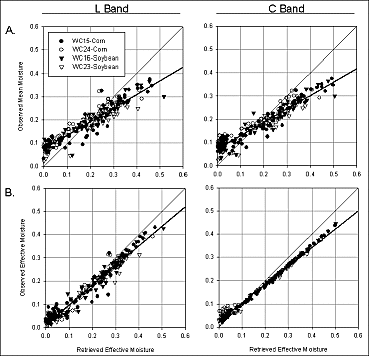
Research
Soil Moisture Experiments in 2002, we measured the near-surface (0-6 cm) soil moisture profile using a standard soil core sampler on four of the 31 study sites. Following extraction, the core was sliced with a wide blade at 1 cm intervals and each was analyzed separately. The moisture and temperature profile data were used in a forward radiative transfer model to generate brightness temperatures at L and C bands. The brightness temperatures were subsequently inverted to retrieve soil moisture. A significant discrepancy was noted between the retrieved and observed moisture. Under relatively dry conditions, the observed moisture overestimates retrieved moisture by about 0.05 volumetric water content (vwc) and underestimates retrieved moisture by about 0.10 vwc under relatively wet conditions (Figure 1). This discrepancy exists in part because retrieved moisture is a depth-dependent effective value whereas observed moisture is a profile mean value. Although the inverse algorithm lumps errors from a number of sources, using the same soil and vegetation properties in the forward and inverse algorithms minimizes the errors from many of these sources thereby permitting us to study this phenomenon.
We characterized the emitting depth responses as a function of depth for each observation and used them as weighting functions to convert the observed mean moisture to observed effective moisture (Figure 2). This effectively removed nearly one-half of the discrepancy noted between retrieved effective moisture and observed mean near-surface moisture. The only remaining difference between the forward RTM and the inverse algorithm is the manner in which the temperature profile is handled. We computed temperature coefficients from the RTM-generated temperature profiles for use in calculating effective temperature in the inverse algorithm. Doing so reduced some of the variability in the relationship between retrieved effective moisture and observed effective moisture, but reduced the bias only slightly. The source of the remaining bias is unknown at this time, but we believe that there is probably a residual temperature effect that is not accounted for in the current retrieval algorithm.
Acknowledgements:
This research was supported by NASA through grant no. 291-07-75-90 to Universities Space Research Association and grant no. NCCW-0084 to Alabama A&M University , Center for Hydrology, Soil Climatology and Remote Sensing.
Reference Cited:
Laymon, C., Manu, A., Crosson, W., and Jackson, T. (1999), Defining the range of uncertainty associated with remotely sensed soil moisture estimates with microwave radiometers, EUROPTO Conference on Remote Sensing for Earth Science Applications, SPIE vol. 3868, 504-512, Florence, Italy, Sept. 20-24.








